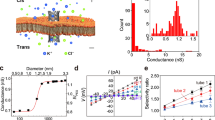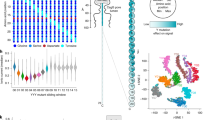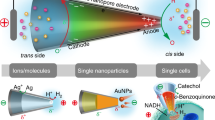Abstract
A distinct advantage of nanosensor arrays is their ability to achieve ultralow detection limits in solution by proximity placement to an analyte. Here, we demonstrate label-free detection of individual proteins from Escherichia coli (bacteria) and Pichia pastoris (yeast) immobilized in a microfluidic chamber, measuring protein efflux from single organisms in real time. The array is fabricated using non-covalent conjugation of an aptamer-anchor polynucleotide sequence to near-infrared emissive single-walled carbon nanotubes, using a variable chemical spacer shown to optimize sensor response. Unlabelled RAP1 GTPase and HIV integrase proteins were selectively detected from various cell lines, via large near-infrared fluorescent turn-on responses. We show that the process of E. coli induction, protein synthesis and protein export is highly stochastic, yielding variability in protein secretion, with E. coli cells undergoing division under starved conditions producing 66% fewer secreted protein products than their non-dividing counterparts. We further demonstrate the detection of a unique protein product resulting from T7 bacteriophage infection of E. coli, illustrating that nanosensor arrays can enable real-time, single-cell analysis of a broad range of protein products from various cell types.
This is a preview of subscription content, access via your institution
Access options
Access Nature and 54 other Nature Portfolio journals
Get Nature+, our best-value online-access subscription
$29.99 / 30 days
cancel any time
Subscribe to this journal
Receive 12 print issues and online access
$259.00 per year
only $21.58 per issue
Buy this article
- Purchase on Springer Link
- Instant access to full article PDF
Prices may be subject to local taxes which are calculated during checkout





Similar content being viewed by others
References
Keasling, J. D. Synthetic biology and the development of tools for metabolic engineering. Metab. Eng. 14, 189–195 (2012).
Kingsmore, S. F. Multiplexed protein measurement: technologies and applications of protein and antibody arrays. Nat. Rev. Drug Discov. 5, 310–320 (2006).
Chikkaveeraiah, B. V., Bhirde, A. A., Morgan, N. Y., Eden, H. S. & Chen, X. Electrochemical immunosensors for detection of cancer protein biomarkers. ACS Nano 6, 6546–6561 (2012).
Kurita, R., Arai, K., Nakamoto, K., Kato, D. & Niwa, O. Development of electrogenerated chemiluminescence-based enzyme linked immunosorbent assay for sub-pM detection. Anal. Chem. 82, 1692–1697 (2010).
Hammock, M. L., Knopfmacher, O., Naab, B. D., Tok, J. B. H. & Bao, Z. A. Investigation of protein detection parameters using nanofunctionalized organic field-effect transistors. ACS Nano 7, 3970–3980 (2013).
Jain, A., Liu, R., Xiang, Y. K. & Ha, T. Single-molecule pull-down for studying protein interactions. Nat. Protoc. 7, 445–452 (2012).
Jain, A. et al. Probing cellular protein complexes using single-molecule pull-down. Nature 473, 484–488 (2011).
Mogalisetti, P. & Walt, D. R. Stoichiometry of the α-complementation reaction of Escherichia coil β-galactosidase as revealed through single-molecule studies. Biochemistry 54, 1583–1588 (2015).
Beyene, A. G., Demirer, G. D. & Landry, M. P. Nanoparticle-templated molecular recognition platforms for detection of biological analytes. Curr. Protoc. Chem. Biol. 8, 197–223 (2016).
Salem, D. P. et al. Chirality dependent corona phase molecular recognition of DNA-wrapped carbon nanotubes. Carbon 97, 147–153 (2016).
Roxbury, D., Mittal, J. & Jagota, A. Molecular-basis of single-walled carbon nanotube recognition by single-stranded DNA. Nano Lett. 12, 1464–1469 (2012).
Tu, X. M., Manohar, S., Jagota, A. & Zheng, M. DNA sequence motifs for structure-specific recognition and separation of carbon nanotubes. Nature 460, 250–253 (2009).
Bisker, G. et al.. Protein-targeted corona phase molecular recognition. Nat. Commun. 7, 10241 (2016).
Nelson, J. T. et al. Mechanism of immobilized protein a binding to immunoglobulin G on nanosensor array surfaces. Anal. Chem. 87, 8186–8193 (2015).
Oliveira, S. F. et al. Protein functionalized carbon nanomaterials for biomedical applications. Carbon 95, 767–779 (2015).
Zhang, J. Q. et al. Molecular recognition using corona phase complexes made of synthetic polymers adsorbed on carbon nanotubes. Nat. Nanotech. 8, 959–968 (2013).
Yang, R. et al. Carbon nanotube-quenched fluorescent oligonucleotides: probes that fluoresce upon hybridization. J. Am. Chem. Soc. 130, 8351–8358 (2008).
Kruss, S. et al. Neurotransmitter detection using corona phase molecular recognition on fluorescent single-walled carbon nanotube sensors. J. Am. Chem. Soc. 136, 713–724 (2014).
Callura, J. M., Cantor, C. R. & Collins, J. J. Genetic switchboard for synthetic biology applications. Proc. Natl Acad. Sci. USA 109, 5850–5855 (2012).
Chen, A. Y. et al. Synthesis and patterning of tunable multiscale materials with engineered cells. Nat. Mater. 13, 515–523 (2014).
Ellis, E. L. & Delbruck, M. The growth of bacteriophage. J. Gen. Physiol. 22, 365–384 (1939).
Nguyen, H. M. & Kang, C. Lysis delay and burst shrinkage of coliphage T7 by deletion of terminator Tφ reversed by deletion of early genes. J. Virol. 88, 2107–2115 (2014).
Taleat, Z., Cristea, C., Marrazza, G., Mazloum-Ardakani, M. & Sandulescu, R. Electrochemical immunoassay based on aptamer–protein interaction and functionalized polymer for cancer biomarker detection. J. Electroanal. Chem. 717, 119–124 (2014).
Jacobs, C. B., Peairs, M. J. & Venton, B. J. Review: carbon nanotube based electrochemical sensors for biomolecules. Anal. Chim. Acta 662, 105–127 (2010).
Rissin, D. M. et al. Single-molecule enzyme-linked immunosorbent assay detects serum proteins at subfemtomolar concentrations. Nat. Biotechnol. 28, 595–599 (2010).
Shi, T. et al. Antibody-free, targeted mass-spectrometric approach for quantification of proteins at low picogram per milliliter levels in human plasma/serum. Proc. Natl Acad. Sci. USA 109, 15395–15400 (2012).
Zijlstra, P., Paulo, P. M. R. & Orrit, M. Optical detection of single non-absorbing molecules using the surface plasmon resonance of a gold nanorod. Nat. Nanotech. 7, 379–382 (2012).
Anker, J. N. et al. Biosensing with plasmonic nanosensors. Nat. Mater. 7, 442–453 (2008).
Ament, I., Prasad, J., Henkel, A., Schmachtel, S. & Sonnichsen, C. Single unlabeled protein detection on individual plasmonic nanoparticles. Nano Lett. 12, 1092–1095 (2012).
Qian, X. M. et al. In vivo tumor targeting and spectroscopic detection with surface-enhanced Raman nanoparticle tags. Nat. Biotechnol. 26, 83–90 (2008).
Sakabe, M. et al. Rational design of highly sensitive fluorescence probes for protease and glycosidase based on precisely controlled spirocyclization. J. Am. Chem. Soc. 135, 409–414 (2013).
Paulus, G. L. C. et al. A graphene-based physiometer array for the analysis of single biological cells. Sci. Rep. 4, 6865 (2014).
Yang, X., Gu, C., Qian, F., Li, Y. & Zhang, J. Highly sensitive detection of proteins and bacteria in aqueous solution using surface-enhanced raman scattering and optical fibers. Anal. Chem. 83, 5888–5894 (2011).
Landry, M. P. et al. Comparative dynamics and sequence dependence of DNA and RNA binding to single walled carbon nanotubes. J. Phys. Chem. C 119, 10048–10058 (2015).
Giraldo, J. P. et al.. A ratiometric sensor using single chirality near-infrared fluorescent carbon nanotubes: application to in vivo monitoring. Small 11, 3973–3984 (2015).
Roxbury, D., Mittal, J. & Jagota, A. Molecular-basis of single-walled carbon nanotube recognition by single-stranded DNA. Nano Lett. 12, 1464–1469 (2012).
Elowitz, M. B., Levine, A. J., Siggia, E. D. & Swain, P. S. Stochastic gene expression in a single cell. Science 297, 1183–1186 (2002).
Lahav, G. et al. Dynamics of the p53-Mdm2 feedback loop in individual cells. Nat. Genet. 36, 147–150 (2004).
Acknowledgements
This work was supported by a Burroughs Wellcome Fund Career Award at the Scientific Interface (CASI), the Simons Foundation, a BBRF young investigator award and a Beckman Foundation Young Investigator Award (to M.P.L.). M.S.S. acknowledges a grant from the National Science Foundation (NSF) to support this work. H.A. is supported by fellowships from the Japan Society for the Promotion of Science and the Naito Foundation. D.Y. acknowledges support from an NSF GRFP fellowship and L.C. acknowledges support from a LAM research fellowship. A.Y.C. acknowledges graduate research support from the Hertz Foundation, the Department of Defense and NIH Medical Scientist Training Program grant T32GM007753. This work was also supported by the National Institutes of Health (DP2 OD008435 and P50 GM098792), the Office of Naval Research (N00014-13-1-0424) and the NSF (MCB-1350625). The authors thank P. Perez-Pinera (University of Illinois Urbana-Champaign) for providing the parental Pichia cells.
Author information
Authors and Affiliations
Contributions
M.P.L. and M.S.S. conceived of the aptamer-anchor nanosensor platform and designed experiments. M.P.L. synthesized aptamer–nanotube conjugates, performed protein selectivity screens and carried out in vitro and cell-based experiments with J.D. and analysed data. H.A., A.C., J.C. and V.I.K. constructed recombinant E. coli strains, H.A. constructed T7RAP1 bacteriophage. M.P.L., H.A., A.C., V.I.K., L.C., D.Y., T.K.L. and M.S.S. discussed the experimental results and wrote the manuscript. All authors discussed the results and commented on the manuscript.
Corresponding author
Ethics declarations
Competing interests
The authors declare no competing financial interests.
Supplementary information
Supplementary information
Supplementary information (PDF 854 kb)
Rights and permissions
About this article
Cite this article
Landry, M., Ando, H., Chen, A. et al. Single-molecule detection of protein efflux from microorganisms using fluorescent single-walled carbon nanotube sensor arrays. Nature Nanotech 12, 368–377 (2017). https://doi.org/10.1038/nnano.2016.284
Received:
Accepted:
Published:
Issue Date:
DOI: https://doi.org/10.1038/nnano.2016.284
This article is cited by
-
Development and evaluation of an expedited system for creation of single walled carbon nanotube platforms
Carbon Letters (2024)
-
High-efficiency upconversion process in cobalt and neodymium doped graphene QDs for biomedical applications
Scientific Reports (2023)
-
Machine learning for the discovery of molecular recognition based on single-walled carbon nanotube corona-phases
npj Computational Materials (2022)
-
Polymer-coated carbon nanotube hybrids with functional peptides for gene delivery into plant mitochondria
Nature Communications (2022)
-
A wavelength-induced frequency filtering method for fluorescent nanosensors in vivo
Nature Nanotechnology (2022)



